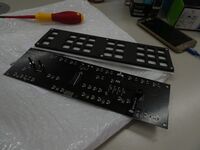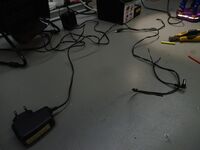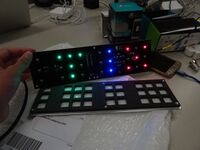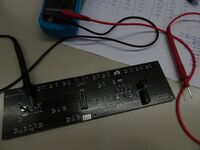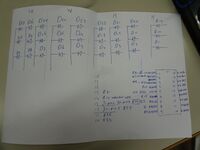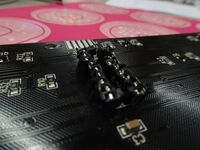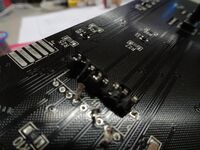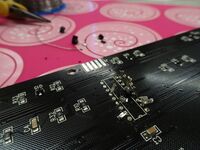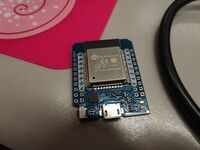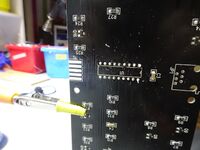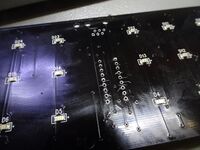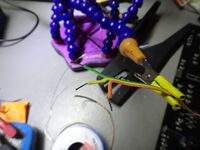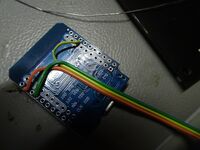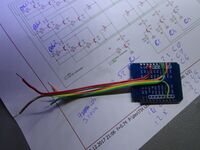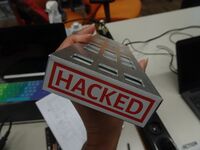TIX clock: Difference between revisions
Created page with " {{Project |Name=TIX clock |Status=In progress |Picture=2019-11-15 181501 - DSC06467.jpg |Contact=Noor }} Have an 'original' TIX clock ('''[https://www.youtube..." |
No edit summary |
||
| (25 intermediate revisions by 2 users not shown) | |||
| Line 1: | Line 1: | ||
{{Project | {{Project | ||
|Name=TIX clock | |Name=TIX clock | ||
|Status= | |Status=Stalled | ||
|Picture=2019-11-15 181501 - DSC06467.jpg | |Picture=2019-11-15 181501 - DSC06467.jpg | ||
|Contact=Noor | |Contact=Noor | ||
|Contact1=bertrik | |||
}} | }} | ||
Have an 'original' TIX clock ('''[https://www.youtube.com/watch?v=5lxyGU6ZkEc YouTube video]''') from ThinkGeek. | Have an 'original' TIX clock ('''[https://www.youtube.com/watch?v=5lxyGU6ZkEc YouTube video]''') from ThinkGeek. | ||
Could also be programmed to display any number up to 4 digits, but the design is best suited for displaying time (blocks are in sets of 3, 9, 6, 9). | |||
== Reverse engineering == | |||
There are a total of 27 LEDs on the board, organised as 9 columns of 3 leds each. | |||
Each column has a shared cathode. | |||
There are a total of 19 transistors on the board. | |||
Each column has its own transistor. | |||
==Schematic== | |||
[[File:TIX.pdf]] | |||
Pins from this schematic: | |||
* top row: RA0, pin 17 | |||
* mid row: RA1, pin 18 | |||
* bot row: RA2, pin 1 | |||
* col 1 (D19/D10/D1): RA6, pin 15 | |||
* col 2 (D20/D11/D2): RB7, pin 13 | |||
* col 3 (D21/D12/D3): RB6, pin 12 | |||
* col 4 (D22/D13/D4): RB5, pin 11 | |||
* col 5 (D23/D14/D5): RB4, pin 10 | |||
* col 6 (D24/D15/D6): RB3, pin 9 | |||
* col 7 (D25/D16/D7): RB2, pin 8 | |||
* col 8 (D26/D17/D8): RB1, pin 7 | |||
* col 9 (D27/D18/D9): RB0, pin 6 | |||
== Software == | |||
Github archive for the software prototype is at https://github.com/bertrik/esptixclock | |||
=== TODO === | |||
* wait for hardware to finish and update the pin map in display.cpp | |||
* power it up, can we perhaps run the entire clock from USB 5V power? | |||
* test it on actual hardware | |||
* fancy startup animations / more display modes / etc | |||
=== Basic principles === | |||
Basic principles of the software are: | |||
* Inspired by the [[LichtKrant]] firmware | |||
* Basic ESP32 Arduino framework | |||
* Simple command interpreter running on the serial port @ 115200bps. | |||
* TIX display driver that alternates between rows and lights up the pixels in the columns | |||
* NTP client to get UTC time from NTP + local time conversion (incl. summer time) | |||
* Main process to convert local time into TIX format (number of LEDs lit in a group indicates number) | |||
Framerate calculation: | |||
At first I'm aiming at a 10 kHz line update rate (= interrupt rate). | |||
Suppose we have 3 rows, 4-bit intensity (16 levels) that means a worst case flicker is 10 kHz / 3 / 16 = 208 Hz. | |||
If this is still too low in practice, we can reduce the dimming resolution, or just use the LEDs at full brightness. | |||
In comparison, a MAX7219 has a "scan-rate" of 800 Hz typically. | |||
=== Building === | |||
==== Arduino IDE ==== | |||
The software can be compiled in the Arduino IDE. | |||
You need the ESP32 toolchain, see https://github.com/espressif/arduino-esp32/blob/master/docs/arduino-ide/boards_manager.md for the instructions. | |||
Also install the following libraries: | |||
* NtpClient, by Fabrice Weinberg, Sandeep Mistry | |||
==== platformio ==== | |||
The software can be built and uploaded to the ESP32 using platformio: | |||
pio run -t upload | |||
The ESP32 toolchain and required libraries will be automatically downloaded from the internet (and cached locally). | |||
Platformio can be installed (on Debian Linux), using: | |||
sudo apt install python3-pip | |||
sudo pip3 install platformio | |||
Add yourself to the 'dialout' group (and log out/in to activate): | |||
sudo adduser <yourlogin> dialout | |||
==Timeline== | |||
'''2019-11''' | |||
Changed out the American plug for an EU one, but the clock requires 60 Hz AC, and 50 Hz will make it run slow and thus useless for telling time. | |||
[[File:2019-11-13 144638 - DSC06464.jpg|200px]] | [[File:2019-11-13 144638 - DSC06464.jpg|200px]] | ||
| Line 18: | Line 91: | ||
[[File:2019-11-15 180508 - DSC06466.jpg|200px]] | [[File:2019-11-15 180508 - DSC06466.jpg|200px]] | ||
[[File:2019-11-15 181501 - DSC06467.jpg|200px]] | [[File:2019-11-15 181501 - DSC06467.jpg|200px]] | ||
'''2020-01-17 - 2019-01-20''' | |||
From an old '''[https://gathering.tweakers.net/forum/list_message/30481141#30481141 Tweakers thread]''': "Dus schoef je wekker eens open en google op het typenummer van de chip. 10 tegen 1 dat er een 60/50Hz-select pootje aanzit. Vaak is die verbonden met een draadbruggetje op de print; omsolderen en klaar!" | |||
Looked into this but no luck. Best bet is to replace the chip (original PIC16F628A, with ESP8266?) and update time via wifi. | |||
Came across '''[https://www.beathis.ch/lgb/tix/tix.html TIX-Uhr]''', describing improvements made to the (European version) TIX. Emailed and got the schematic from This Manhart. | |||
Removed the original chip completely, to be replaced with an ESP32. | |||
[[File:2020-01-18 182119 - DSC08511.jpg|200px]] | |||
[[File:2020-01-19 172607 - DSC08533.jpg|200px]] | |||
[[File:2020-01-19 205609 - DSC08534.jpg|200px]] | |||
[[File:2020-01-19 205845 - DSC08535.jpg|200px]] | |||
[[File:2020-01-19 205943 - DSC08536.jpg|200px]] | |||
[[File:2020-01-19 210011 - DSC08537.jpg|200px]] | |||
[[File:2020-01-19 210714 - DSC08538.jpg|200px]] | |||
[[File:2020-01-19 211758 - DSC08539.jpg|200px]] | |||
[[File:2020-01-19 212233 - DSC08540.jpg|200px]] | |||
[[File:2020-01-19 212635 - DSC08541.jpg|200px]] | |||
[[File:2020-01-19 213004 - DSC08543.jpg|200px]] | |||
[[File:2020-01-19 213104 - DSC08545.jpg|200px]] | |||
== External links == | |||
* '''[https://www.beathis.ch/lgb/tix/tix.html TIX-Uhr]''' | |||
Latest revision as of 13:19, 11 May 2020
| Project TIX clock | |
|---|---|
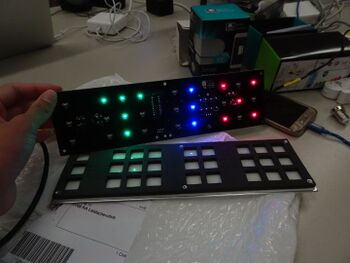
| |
| Status | Stalled |
| Contact | Noor, bertrik |
| Last Update | 2020-05-11 |
Have an 'original' TIX clock (YouTube video) from ThinkGeek.
Could also be programmed to display any number up to 4 digits, but the design is best suited for displaying time (blocks are in sets of 3, 9, 6, 9).
Reverse engineering
There are a total of 27 LEDs on the board, organised as 9 columns of 3 leds each. Each column has a shared cathode.
There are a total of 19 transistors on the board. Each column has its own transistor.
Schematic
Pins from this schematic:
- top row: RA0, pin 17
- mid row: RA1, pin 18
- bot row: RA2, pin 1
- col 1 (D19/D10/D1): RA6, pin 15
- col 2 (D20/D11/D2): RB7, pin 13
- col 3 (D21/D12/D3): RB6, pin 12
- col 4 (D22/D13/D4): RB5, pin 11
- col 5 (D23/D14/D5): RB4, pin 10
- col 6 (D24/D15/D6): RB3, pin 9
- col 7 (D25/D16/D7): RB2, pin 8
- col 8 (D26/D17/D8): RB1, pin 7
- col 9 (D27/D18/D9): RB0, pin 6
Software
Github archive for the software prototype is at https://github.com/bertrik/esptixclock
TODO
- wait for hardware to finish and update the pin map in display.cpp
- power it up, can we perhaps run the entire clock from USB 5V power?
- test it on actual hardware
- fancy startup animations / more display modes / etc
Basic principles
Basic principles of the software are:
- Inspired by the LichtKrant firmware
- Basic ESP32 Arduino framework
- Simple command interpreter running on the serial port @ 115200bps.
- TIX display driver that alternates between rows and lights up the pixels in the columns
- NTP client to get UTC time from NTP + local time conversion (incl. summer time)
- Main process to convert local time into TIX format (number of LEDs lit in a group indicates number)
Framerate calculation: At first I'm aiming at a 10 kHz line update rate (= interrupt rate). Suppose we have 3 rows, 4-bit intensity (16 levels) that means a worst case flicker is 10 kHz / 3 / 16 = 208 Hz. If this is still too low in practice, we can reduce the dimming resolution, or just use the LEDs at full brightness. In comparison, a MAX7219 has a "scan-rate" of 800 Hz typically.
Building
Arduino IDE
The software can be compiled in the Arduino IDE.
You need the ESP32 toolchain, see https://github.com/espressif/arduino-esp32/blob/master/docs/arduino-ide/boards_manager.md for the instructions.
Also install the following libraries:
- NtpClient, by Fabrice Weinberg, Sandeep Mistry
platformio
The software can be built and uploaded to the ESP32 using platformio:
pio run -t upload
The ESP32 toolchain and required libraries will be automatically downloaded from the internet (and cached locally).
Platformio can be installed (on Debian Linux), using:
sudo apt install python3-pip sudo pip3 install platformio
Add yourself to the 'dialout' group (and log out/in to activate):
sudo adduser <yourlogin> dialout
Timeline
2019-11
Changed out the American plug for an EU one, but the clock requires 60 Hz AC, and 50 Hz will make it run slow and thus useless for telling time.
2020-01-17 - 2019-01-20
From an old Tweakers thread: "Dus schoef je wekker eens open en google op het typenummer van de chip. 10 tegen 1 dat er een 60/50Hz-select pootje aanzit. Vaak is die verbonden met een draadbruggetje op de print; omsolderen en klaar!"
Looked into this but no luck. Best bet is to replace the chip (original PIC16F628A, with ESP8266?) and update time via wifi.
Came across TIX-Uhr, describing improvements made to the (European version) TIX. Emailed and got the schematic from This Manhart.
Removed the original chip completely, to be replaced with an ESP32.

